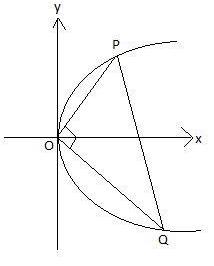Answer
414k+ views
Hint: Assume that the chord is normal to the parabola at point P whose coordinate is given as $P\left( a{{t}^{2}},2at \right)$. Now, let this chord meet the parabola again at Q whose coordinate is given by $Q\left( a{{t}_{1}}^{2},2a{{t}_{1}} \right)$. O is the origin and the vertex of the parabola ${{y}^{2}}=4ax$. Find a relation between t and ${{t}_{1}}$ by equating the product of slopes of line OP and OQ equal to -1. Form another equation by the help of the general equation of normal to the parabola given by $y=mx-a{{m}^{3}}-2am$, where m is the slope of normal PQ. Solve the two equations to get the value of ${{t}^{2}}$.
Complete step-by-step solution -

We know that, if two lines are perpendicular to each other then the product of their slopes is equal to $-1$. In the above question, since PQ subtends a right angle at the vertex of parabola, that is origin, therefore, OP and OQ are perpendicular.
Slope of line OP $=\dfrac{\Delta y}{\Delta x}=\dfrac{2at-0}{a{{t}^{2}}-0}=\dfrac{2}{t}$
Slope of line OQ $=\dfrac{\Delta y}{\Delta x}=\dfrac{2a{{t}_{1}}-0}{a{{t}_{1}}^{2}-0}=\dfrac{2}{{{t}_{1}}}$
Taking the product of slopes, we get,
$\begin{align}
& \dfrac{2}{t}\times \dfrac{2}{{{t}_{1}}}=-1 \\
& \Rightarrow t{{t}_{1}}=-4....................(i) \\
\end{align}$
Now, since PQ is a normal to the parabola and the general equation of a parabola is $y=mx-a{{m}^{3}}-2am$, where m is the slope of normal PQ.
Since, the line PQ passes through $P\left( a{{t}^{2}},2at \right)$, therefore, substituting the coordinates in $y=mx-a{{m}^{3}}-2am$, we get,
$\begin{align}
& 2at=ma{{t}^{2}}-a{{m}^{3}}-2am \\
& \Rightarrow a{{m}^{3}}+2am-am{{t}^{2}}+2at=0 \\
& \Rightarrow {{m}^{3}}+2m-m{{t}^{2}}+2t=0 \\
\end{align}$
Substituting m = -t in the above equation, we get,
$\begin{align}
& {{\left( -t \right)}^{3}}+2\left( -t \right)-\left( -t \right){{t}^{2}}+2t \\
& =-{{t}^{3}}-2t+{{t}^{3}}+2t \\
& =0 \\
\end{align}$
Therefore, ‘-t’ is the slope of line PQ.
Also, slope of the line PQ \[=\dfrac{\Delta y}{\Delta x}=\dfrac{2at-2a{{t}_{1}}}{a{{t}^{2}}-a{{t}_{1}}^{2}}=\dfrac{2a(t-{{t}_{1}})}{a\left( {{t}^{2}}-{{t}_{1}}^{2} \right)}=\dfrac{2a(t-{{t}_{1}})}{a\left( t-{{t}_{1}} \right)\left( t+{{t}_{1}} \right)}\]
Cancelling the common terms, we get,
Slope of line PQ $=\dfrac{2}{(t+{{t}_{1}})}$
Therefore, equating (-t) with $\dfrac{2}{(t+{{t}_{1}})}$, we have,
$\begin{align}
& \dfrac{2}{(t+{{t}_{1}})}=-t \\
& \Rightarrow -{{t}^{2}}-t{{t}_{1}}=2...................(ii) \\
\end{align}$
Substituting the value of $t{{t}_{1}}$ from equation (i) in equation (ii), we get,
$\begin{align}
& -{{t}^{2}}-\left( -4 \right)=2 \\
& \Rightarrow -{{t}^{2}}+4=2 \\
& \Rightarrow {{t}^{2}}=2 \\
\end{align}$
Hence, option (b) is the correct answer.
Note: One may note that the equation of normal to the parabola is a cubic equation in ‘m’ that means a total of three normal can be drawn from a point outside the parabola. We have used a hit and trial method to determine one of the values of ‘m’ in terms of ‘t’. The other two values of ‘m’ are of no use here because we are already getting a simplified relation between t and ${{t}_{1}}$.
Complete step-by-step solution -

We know that, if two lines are perpendicular to each other then the product of their slopes is equal to $-1$. In the above question, since PQ subtends a right angle at the vertex of parabola, that is origin, therefore, OP and OQ are perpendicular.
Slope of line OP $=\dfrac{\Delta y}{\Delta x}=\dfrac{2at-0}{a{{t}^{2}}-0}=\dfrac{2}{t}$
Slope of line OQ $=\dfrac{\Delta y}{\Delta x}=\dfrac{2a{{t}_{1}}-0}{a{{t}_{1}}^{2}-0}=\dfrac{2}{{{t}_{1}}}$
Taking the product of slopes, we get,
$\begin{align}
& \dfrac{2}{t}\times \dfrac{2}{{{t}_{1}}}=-1 \\
& \Rightarrow t{{t}_{1}}=-4....................(i) \\
\end{align}$
Now, since PQ is a normal to the parabola and the general equation of a parabola is $y=mx-a{{m}^{3}}-2am$, where m is the slope of normal PQ.
Since, the line PQ passes through $P\left( a{{t}^{2}},2at \right)$, therefore, substituting the coordinates in $y=mx-a{{m}^{3}}-2am$, we get,
$\begin{align}
& 2at=ma{{t}^{2}}-a{{m}^{3}}-2am \\
& \Rightarrow a{{m}^{3}}+2am-am{{t}^{2}}+2at=0 \\
& \Rightarrow {{m}^{3}}+2m-m{{t}^{2}}+2t=0 \\
\end{align}$
Substituting m = -t in the above equation, we get,
$\begin{align}
& {{\left( -t \right)}^{3}}+2\left( -t \right)-\left( -t \right){{t}^{2}}+2t \\
& =-{{t}^{3}}-2t+{{t}^{3}}+2t \\
& =0 \\
\end{align}$
Therefore, ‘-t’ is the slope of line PQ.
Also, slope of the line PQ \[=\dfrac{\Delta y}{\Delta x}=\dfrac{2at-2a{{t}_{1}}}{a{{t}^{2}}-a{{t}_{1}}^{2}}=\dfrac{2a(t-{{t}_{1}})}{a\left( {{t}^{2}}-{{t}_{1}}^{2} \right)}=\dfrac{2a(t-{{t}_{1}})}{a\left( t-{{t}_{1}} \right)\left( t+{{t}_{1}} \right)}\]
Cancelling the common terms, we get,
Slope of line PQ $=\dfrac{2}{(t+{{t}_{1}})}$
Therefore, equating (-t) with $\dfrac{2}{(t+{{t}_{1}})}$, we have,
$\begin{align}
& \dfrac{2}{(t+{{t}_{1}})}=-t \\
& \Rightarrow -{{t}^{2}}-t{{t}_{1}}=2...................(ii) \\
\end{align}$
Substituting the value of $t{{t}_{1}}$ from equation (i) in equation (ii), we get,
$\begin{align}
& -{{t}^{2}}-\left( -4 \right)=2 \\
& \Rightarrow -{{t}^{2}}+4=2 \\
& \Rightarrow {{t}^{2}}=2 \\
\end{align}$
Hence, option (b) is the correct answer.
Note: One may note that the equation of normal to the parabola is a cubic equation in ‘m’ that means a total of three normal can be drawn from a point outside the parabola. We have used a hit and trial method to determine one of the values of ‘m’ in terms of ‘t’. The other two values of ‘m’ are of no use here because we are already getting a simplified relation between t and ${{t}_{1}}$.
Recently Updated Pages
Assertion The resistivity of a semiconductor increases class 13 physics CBSE

The Equation xxx + 2 is Satisfied when x is Equal to Class 10 Maths

How do you arrange NH4 + BF3 H2O C2H2 in increasing class 11 chemistry CBSE

Is H mCT and q mCT the same thing If so which is more class 11 chemistry CBSE

What are the possible quantum number for the last outermost class 11 chemistry CBSE

Is C2 paramagnetic or diamagnetic class 11 chemistry CBSE

Trending doubts
Difference between Prokaryotic cell and Eukaryotic class 11 biology CBSE

Fill the blanks with the suitable prepositions 1 The class 9 english CBSE

Two charges are placed at a certain distance apart class 12 physics CBSE

Difference Between Plant Cell and Animal Cell

What organs are located on the left side of your body class 11 biology CBSE

Change the following sentences into negative and interrogative class 10 english CBSE

The planet nearest to earth is A Mercury B Venus C class 6 social science CBSE

The Equation xxx + 2 is Satisfied when x is Equal to Class 10 Maths

What is BLO What is the full form of BLO class 8 social science CBSE



